Ankara and Istanbul: A Tale of Two Cities
- Aaron Schorr
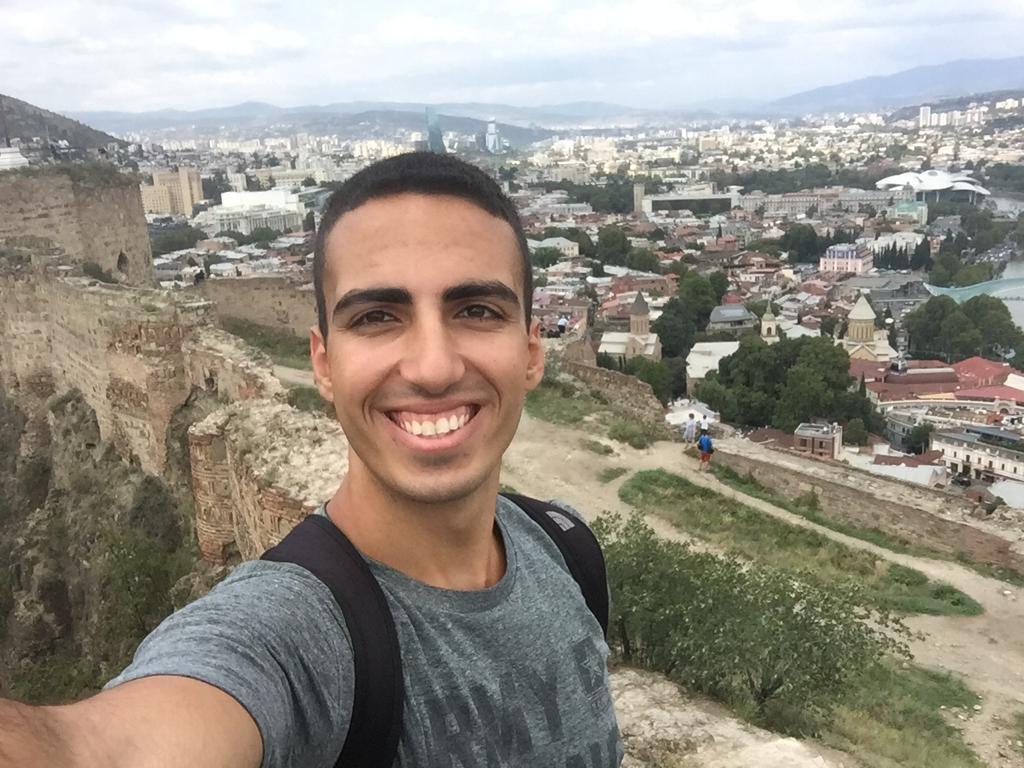
- Aug 7, 2021
- 17 min read
Göreme had a famous carpet shop, which we visited the next morning. The shopkeeper was very eager to show us his wares, some of which were absolutely stunning. The top floor was something straight out of a movie, something that clearly did not go unnoticed by yet another couple taking wedding photos there. This was the fourth such couple I had seen since arriving in Cappadocia, and the shopkeeper confirmed that it was peak wedding season.
We had offered Bothena a ride to Ankara, and she took us up on as we were preparing to leave. As we were checking out of the hostel, Kailash materialized and asked if he could ride with us as well. There was definitely something going on between these two, but I wasn’t quite sure what yet. The four of us piled into the car and said goodbye to Cappadocia, which had exceeded all of our expectations. We got onto a toll road, which had recently been upgraded with automatic toll collection, so there were still signs for some sort of pass, cash, and credit. Some confusion ensued, but other cars waved us forward so we assumed we were ok. The road was fine of the best I’ve ever driven on, easily competing with German autobahns, but very eerily empty as we sped through the Anatolian countryside.
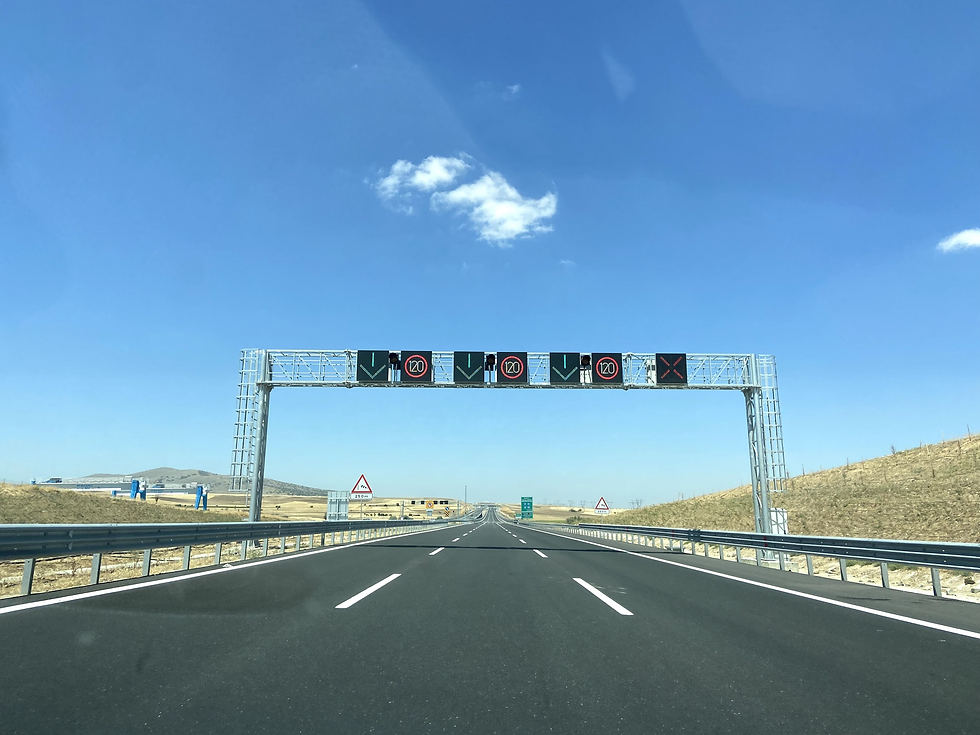
We made fantastic time and emerged at Tuz Gölü, nominally Turkey’s second-largest lake. The catch is that it’s a salt lake, and this late in the summer it’s really a massive salt flat, over 60 km from top to bottom. It was a surreal sight, a flat white expanse stretching to the hazy horizon. If it weren’t so hot, it would almost look like snow. To get to the “lake” itself, we had to pass through a visitors center selling dozens of salt cosmetic products - it could have been the Dead Sea just as well. We walked onto the blindingly white flats, the salt crystals crunching beneath our shoes and a little stream of salt water reminding us that this was once a lake. Yotam and I dared Kailash to walk through the stream so we could see Jesus walking on water, but he told us that someone had made the same joke in the hostel the previous day.
A Taste of Yemen
Back in the car, we continued towards Ankara on another excellent highway, passing several buses serving the Baghdad-Istanbul route. The terrain became more mountainous, and skyscrapers emerged in the distance, multiplying as we got closer. We passed through a massive stone gate to enter the city and drove to a hostel Kailash had found. I had come to Ankara with one goal in mind - to visit Ataturk’s mausoleum - but we had all barely eaten all day and it was already 3 pm. Finding parking was a challenge, until we spotted a block with traffic cones lining the sidewalk. A man emerged out of a café, moved one of the cones, and charged us 20 TL ($2.5) to park overnight. We checked into the darkest hostel I had ever seen, and conveniently got a 4-bed room to ourselves. Two other guests recommended a restaurant to Bothena, only a short walk from the hostel.

Our neighborhood felt like a more modern Tel Aviv, a grid of streets lined with cafés and bars arrayed around a medical school. The clientele at the restaurant was unexpected - lots of families who looked East African, the women all dressed in modest Islamic tradition with hijabs covering their hair. We sat down and noticed that the menu was written in both Turkish and Arabic, and I noticed the word “yamani” several times. Bothena practically leapt out of her chair as we realized that we had found a Yemeni restaurant completely by chance, which explained the other patrons.
Bothena took control of ordering, and soon enough we had four different rice and meat dishes with lamb and chicken. Everything tasted pretty similar, but it was absolutely delicious and the check only came out to 277 TL ($33) for the four of us. Bothena told us more of her story - her parents had moved back to Yemen when she was 17 and she stayed in Germany to go to medical school. She visited Yemen last year, flying to Aden because the Sana’a airport was unsafe and taking a 10-hour bus ride through desert valleys to evade Houthi rebel forces with checkpoints every few kilometers. There was a Yemeni man of about 40 sitting next to us who was perplexed by our mix of languages at the table - the conversation moved between English, Hebrew, German, and Spanish. We explained our origins, and I gave him the Aleppo spiel in broken Arabic, which got his approval. I then pointed at Yotam - “hu min Isra’il.” He seemed impressed, and shared the news with the rest of his table. When the check came, he offered to pay for us, saying that Bothena was family.

Bothena's and my shoes were completely falling apart, so we found a shopping mall nearby and attempted to take the bus there sans Kailash. The bus arrived on time, but we had no idea how to pay, and my credit card didn’t work on the payment machine. The driver waved us in and pointed at some woman, but she avoided eye contact with us. We merged into traffic, and the driver left the front door open. I then noticed that every other bus and van driver did so as well, and that our bus had made an unexpected turn off its online route. Still, we managed to find our way to the mall after nearly wandering into a police station which looked like it could have been in the Green Zone in Baghdad with the amount of security it had.

I found a shoe outlet in the mall, but finding shoes in my size was going to be a challenge. I’m usually a 47, and a search through the entire men’s section yielded precisely 6 size 46 pairs and not a single 47. One of the 46s eventually fit, and I hoped that a sub-$20 pair of shoes would survive the rest of the trip.
Selim the Environmentalist
Our next stop was Ankara’s old city, and I was thrilled to see there was a subway going in the right direction. It was 4 TL ($0.5) to ride, and so much faster than the traffic clogging the main roads as we sped by in a brand new Chinese-built train. The subway station was in the valley and the citadel was at the top of the hill, nearly 100 meters higher. We started walking up, but Bothena was exhausted and looked on the verge of collapse. We hopped in a taxi, which took us to the top for 12 TL ($1.5), less than the starting price of an Israeli taxi.

The citadel offered amazing views of the city, which was so much larger than I had expected. I thought Ankara was just another backwater planned capital like Brasilia, but it stretched across every hill in all directions. Much of it looked very similar to Jerusalem, but the central area was all bombastic monuments symbolizing the power of the Turkish nation. Gençlik Park, which had a quarter-mile long reflecting pool and a Ferris wheel, was right next to the new high-speed rail station the size of an airplane factory and the triangle-shaped Çagdan concert hall. Above all towered Anıtkabir, Ataturk’s mausoleum (which was closed by the time we were done eating), designed to be visible from every part of the city at the time of its construction. As the sun crept towards the horizon, we were joined by Shahzad, who had managed to get the last seat on a bus to Ankara by posing as the boyfriend of a Russian Instagram influencer he met at the bus station.
I noticed a guy on a bike with a big sign on the back, and walked over to ask what it was. He introduced himself as Selim and said the sign was sign was to educate drivers on the dangers of pollution. His excitement was infectious as he told me how he rode his bike from Konya to here and around Poland when he was an exchange student there. We added each other on Facebook, and he asked whether we had any problems in Ankara. “If you have any problem, just call me.” Leaving the citadel, a young boy of about 3 or 4 ran up to Bothena and started chatting with her in Turkish. His father fed him phrases in English which he attempted to repeat, and asked me and her to pose for a photo with him. It was a very strange moment, especially since neither of us looked particularly out of place in Turkey.

We hailed a taxi back to the hostel, the first manual Toyota Corolla I had ever seen. The driver spent nearly the entire drive in fifth gear, and would have gotten us back in about six minutes if he hadn’t made a series of wrong turns and ended up on the opposite end of our neighborhood. He asked another driver where to go, we tried giving him instructions and hopped out when we were close enough to walk.
We passed by a bar with live music and returned to it after a brief rendezvous with Kailash. The doorman wanted something from us, but one of the waitresses told him everything was ok and waved us in to sit at the last free table. A band got up to play what sounded like Turkish pop music a few minutes later, and the crowd went wild. The singer and clarinet player were really good, and everyone in the bar seemed to know every single word of every song, singing along as if it was a concert at a festival. The energy was incredible, and the fact that we were the only foreigners there made it so much better. Between songs, Shahzad told me more of his story - his wife and three kids were visiting his mother-in-law in Pakistan and couldn’t leave because their flights had been cancelled. The mother-in-law was her husband’s second wife, and he had moved to Norway with his first wife. Since Norway didn’t allow polygamy, she had to stay in Pakistan, and stayed there to this day. Yotam and I helped a drunk and exhausted Bothena get back to the hostel and rewarded ourselves with some of the best baklava I’ve ever had.

Anıtkabir: The Second-Best Egomaniacal Tomb Complex
We got up early the next morning to get to Anıtkabir right when it opened. After a delicious börek for breakfast, we got to the gates of the complex 15 minutes before it opened to find about a dozen Turks waiting in a shockingly orderly line to enter. The gardens surrounding the place were very well kept, but a short walk up the hill brought us to the main attraction. We walked past a Turkish flag flanked by an honor guard and found ourselves in a stone plaza roughly 100 meters wide and at least as long. Columned buildings ringed it on three sides, one of which opened to a tree-lined boulevard as broad as the Champs Elysées lined with two dozen lions representing Turkey’s various tribes. The fourth side had several dozen marble steps leading up to the main structure, a 17-meter high travertine shrine built in a suspiciously Greek style (this sentence is probably punishable by death in Turkey).
We walked up and into the building, finding ourselves in a column-lined marble hall lined with lamps shaped like torches and with gold-inlayed mosaics on the ceiling. On either side of the entrance was a 12-meter high inscription of two of Ataturk’s speeches, preparing visitors for the 40-ton sarcophagus in the center of the hall (but the actual tomb was in a subterranean chamber).
We emerged from the shrine back on the plaza and followed the signs to the museum. The architecture had been impressive, but the museum was the real treat. The first few rooms were dedicated to various personal belongings of Ataturk’s, including a rather haram glass case full of wine glasses and carafes and a multilingual book collection from which Turkish was notably absent. There was also a collection of Ataturk’s awards, including the gold and silver Medals of Privilege bestowed by Sultan Mehmed V, an award I desperately want to transport to Yale.
Next came “The Museum of the War of Independence”, the most intensely nationalistic place I had ever seen in my life. A series of rooms had life-sized dioramas of various Turkish battlefields from the 1910s and 20s, complete with running streams and sounds of gunfire and neighing horses, and always with Ataturk and his commanders watching the battlefield vigilantly. Next were a series of paintings depicting various aspects of the national struggle for independence interspersed with portraits of Ataturk and his generals. My favorite was titled Selfless Contributions Made by Turkish Women in the National Struggle which sounded straight out of the Chinese Communist Party’s book and was complete with an old man making tea as stone-faced women made shells and hauled them to the front towards a glorious victory over the British, the French, and the dreaded Greeks. These were portrayed massacring Turkish civilians as an Orthodox priest egged them on, with a sign proclaiming that “the fact that clerics played a provoking role has been proven by historical evidence.” A similar portrayal of Turkish soldiers massacring Armenian civilians was not to be found.
It was all incredibly emotional for a series of wars which ended 98 years ago, and designed to impress. It did that well, but it wasn’t as impressive as the other incredibly over-the-top egomaniacal mausoleum to a national father figure I had visited - the one dedicated to Chiang Kai-Shek in Taipei.
Istanbul
Kailash, Yotam, and I said goodbye to Bothena and picked up Shahzad from his hotel. We set off to the north-west on another fantastic toll road, but this one was not eerily empty of traffic. We climbed to a pass at nearly 1,600 meters to reach the city of Bolu, after which the scenery became entirely green. I had a hip-hop playlist on shuffle, and the racial language must have caught Shahzad’s attention. "You know, the Black people call each other n-words [he used the hard-r version], but we cannot call them that. Even the Somalis in Norway do that. What do you think about this?” I told him that there was plenty of material written about this topic in American media, and he should check it out.
A little over 3 hours in, the Sea of Marmara became visible in the left side. We crossed dozens of bridges and a handful of tunnels as the road got busier and and the scenic landscape was replaced by heavy industry, explaining the masses of trucks on the highway. Entering Istanbul was a gradual process rather than a moment, and soon enough the road went underground and we entered Avrasya Tüneli - the Eurasian Tunnel - which let us out in Istanbul’s old town on the European side.
The Ultimate Driving Challenge
Our hostel was in the Sultanahmet neighborhood, a maze of steep, narrow, winding cobblestone streets. It would have been challenging enough to drive through in a stick car empty, but the stop-and-go traffic made things that much worse. Other cars seemed to emerge from every which direction, delivery vans blocked entire streets, and pedestrians materialized out of every blind spot. Finding parking seemed an impossible task, until we suddenly spotted a car vacating a spot in a parking lot. We all cheered, and Kailash promised to make me a certificate qualifying me to drive anywhere on Earth.
We climbed out into air that felt like soup to find a middle-aged man waving at us. He mediated between us and the parking attendant, explaining that we could pay 20 TL ($2.5) to park there until evening, but we would have to move before morning, when the lot became a farmers’ market. The man introduced himself as Rocky and invited us to taste some sweets in his shop. “I have all kinds of sweets and I can vacuum pack everything for you - where there’s a will, there’s a way.” He was clearly a seasoned smooth-talker, but decided to humor him. He explained that his "family" was from Van in eastern Turkey, but 18,000 of them now lived in Istanbul. His niece gave us all water and tastes of delicious Turkish delight, and his nephew took a picture of our strange group. He gave us all his card and we promised to return to buy some of his merchandise as souvenirs.

We wandered around the old time until it was time for dinner, acclimating to the massive change of pace that was Istanbul. The entire city seemed to be a shifting mass of cars, trams, and people, visibly European but with lots of Turkish flair. For dinner, we were meeting Rayyan, a classmate of mine from the Maldives who was spending a month in Istanbul since he couldn’t return home without a lengthy quarantine in a hotel. Google Maps said we had to take the Marmaray commuter rail back to the Asian side, and there was a station nearby in Sirkeci. There were only two functioning ticket machines in the station, and the locals all used them to top up their cards. To be able to ride the train, we had to: 1) buy new individual cards, 2) put money on the cards, 3) “activate” the cards, 4) link our cards to our unique health codes provided to us by the Turkish government when we arrived (this step was an even more performative public health measure than anything I had seen at Yale). Of course, there was no explanation of this anywhere, so after each step we went to the turnstiles to see if they opened and returned to the line when they didn’t.
After about 15 minutes, we finally made it in and onto the train to Asia. To leave the subway station, we had to pass through another turnstile. We thought we had to swipe our cards and wait for the screen to turn green, but after many failed attempts we finally figured out that the gates were simply motion-activated. I have never felt like a more clueless tourist in my life.


The train had taken us to Kadıköy, a hip neighborhood with a very different feel from the old town. The walk to the center of the district where we were to meet Rayyan took us through lots of bustling streets, but the people on them were all Turkish and the stores were clearly not catering to tourists. It was hot and sticky, the temperature still above 30˚ (86˚ F) as the sun began to set, but Rayyan - being from Mauritius - emerged in slacks and a denim jacket, apparently unfazed by the heat. He took us to a small kebab restaurant, where we feasted on Adana (minced lamb) and çöp şiş (cubed beef) kebab, with künefe from a nearby stand for dessert. The food was served on plates with dürüm flatbread, onions, hot peppers, and tomatoes, perfect for sharing.
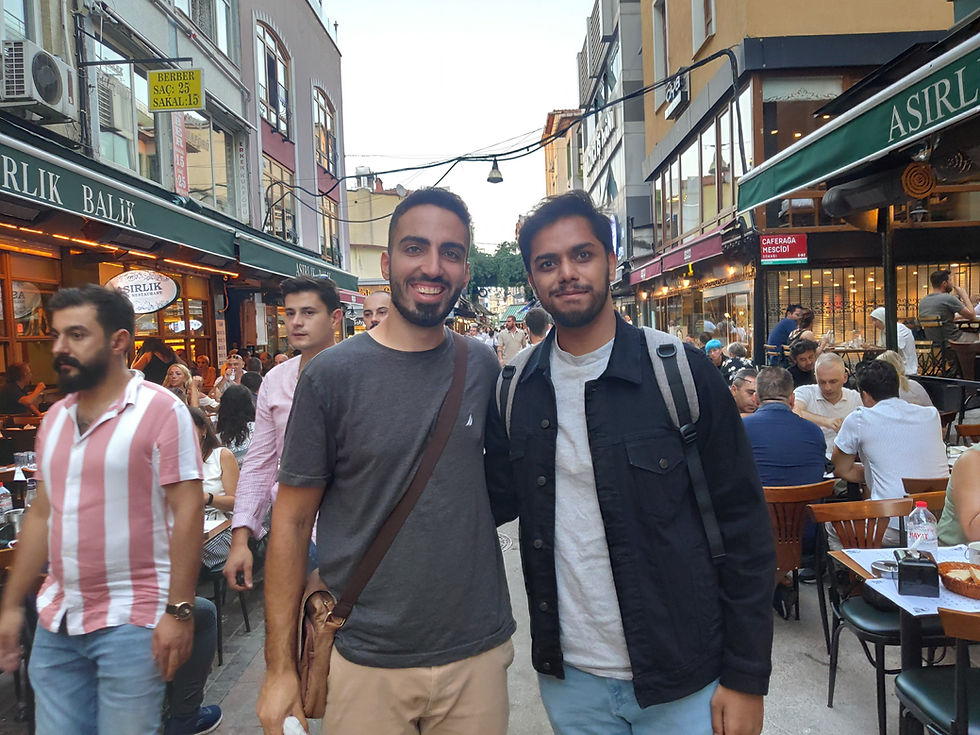
The trip back to the hostel was much smoother than the outbound trip, and I managed to find a parking spot directly in front of the hostel. Several guests were hanging out on the sidewalk, and I joined them in conversation. One of them was a Jordanian online marketer in his late twenties named Rakan. I had never met a Jordanian abroad before, and talking to him was fascinating. He almost certainly had Palestinian heritage, but he spoke about Israel in economic terms as if it were an extension of Europe - a great place to live and work, though he positively balked when I told him how much my rent in Tel Aviv was. One aspect of life in Jordan made me laugh in particular: “Tinder in Amman is all Israeli girls from Jerusalem, and so many soldiers. In Jordan, we have women in the military too, but not beautiful women.”

The Mosque Which Was a Church
The next day was devoted to exploring Istanbul. After a great breakfast on the hostel's terrace overlooking the Sea of Marmara, we headed to the square in front of Hagia Sophia to join a free walking tour. These have become my favorite way to explore a new city, and I hoped today would be no different. We met our guide, Yaş, and the rest of our group, one of whom was improbably a student at the Yale School of Management.
From the exterior, Hagia Sophia was rather more shabby-looking than I had expected, given its rich history. Built in 537, it was the epicenter of the Orthodox church until the fall of Constantinople in 1453, after which it became a mosque. The Blue Mosque, built by Sultan Ahmed I and named after him, then became the most important place of worship in the city (it was under renovation, so we didn't visit it). As part of his efforts to secularize Turkey, Ataturk converted Hagia Sophia to a museum in the 1930s, but Erdogan ("our new sultan", according to Yaş) made a big point of making it a mosque once again last year, so that it is now known as Ayasofya-i Kebir Cami-i Şerifi (The Hagia Sophia Grand Mosque).

For a mosque, Hagia Sophia is highly unusual, and its colorful history is visible everywhere. Since it is officially a World Heritage site, the artwork inside cannot be modified, so that the foyer has large mosaics depicting Jesus, Mary, Justinian I, and other human figures, which is expressly forbidden in Islam. The structure also faces Jerusalem and not Mecca, which are offset by about 3.4 compass degrees, so that the mihrab was not quite in the center of the otherwise perfectly symmetrical structure. There are also crosses on the walls which were simply glossed over with flower motifs so as to not be haram. Mid-explanation, Yaş suddenly pointed at a nearby tour guide. “Look, that’s my ex-wife!” They politely said hello to each other, which was surprising considering he had just told us that the years married to her was the worst period of his life.
From Hagia Sophia, we headed to nearby Topkapı Palace, home of the Ottoman sultans. The gates and outer courtyard were gorgeous, but the heat was rapidly becoming oppressive and the inner courtyards cost 285 TL ($33) to access. The palace faced the old Roman hippodrome, which had 3 obelisks in its center, thus combining many periods of history under the omnipresent Turkish flags. Yaş said the old hippodrome was 120 by 700 meters and could seat 100,000 spectators, but a nearby guide told his group in Spanish that it was 200 by 600 meters and sat 30,000 about a minute later. They should really get their stories straight.

Halabis in the Grand Bazaar
After the tour, we found ourselves at yesterday’s parking lot, which had indeed become a farmers’ market. We bought plenty of fruit, including some of the peaches I ever had, and set off towards the Grand Bazaar.

Yaş had briefed us on how to navigate the bazaar, but I was not ready for how over-the-top it was. First off, the structure housing the bazaar was beyond beautiful, even if much of it was in disrepair, and dangerously labyrinthian. The shops varied wildly between the lovely (colorful carpets, jewelry, and fabrics), the garish (trinkets and fake designer brands), and the delicious (spices, nuts, and Turkish delight). Yaş had told us that shopkeepers will invite you in for tea and get you to buy their wares with a combination of guilt and charm, and indeed we received many invitations for tea which we politely declined.
I really wanted some Turkish delight, and a guy who looked about my age offered us a taste of some which was very good. He made us two different kinds of tea - “this one is for energy, this is to relax” - and we bought some tea and Turkish delight. Practically every shopkeeper asked us where we were from, but he kept asking me where my family was from after we said we were Israeli. Eventually, I gave in and said my mother’s family was from Aleppo, and he gave me a big smile and said that he was, too. He introduced himself as Mohammed and said that he had came from Aleppo to Istanbul in 2012, at the very beginning of the Syrian Civil War. We shook hands and took a selfie, and he gave us some extra tea. With Aleppo's iconic souk destroyed in the war, I was happy that there was some continuity.

After running into Danya at a random shop, we explored the maze of shopping streets adjacent to the bazaar, which I came to think were to the bazaar what off-Broadway shows were to Broadway. The shops were all highly specialized - most seemed to sell either military surplus equipment or beaded necklaces - and extremely cheap. Being open to the air and on the road, though, they had a very different feeling, accentuated by the honking of the cars stuck in the never-ending stationary traffic jams.
For lunch, Yaş had recommended that we tried kokoreç, which has the most Hungarian-sounding name ever but is actually Turkish. It is made from sheep’s intestines and other entrails grilled over charcoal and served in bread with onions, and its vendors seem to be concentrated on one street north of the bazaar. I thought the flavor would be too much for me, but it was actually quite delicious and totally different from Jerusalem mixed grill.

Bosphorus Cruises for Backpackers
Yaş had invited us on a Bosphorus cruise, but we thought it was too hazy to be worth it. Instead, we ended the day of touring with a public ferry across the Bosphorus to Kadıköy. It was 4.6 TL (54¢), and there were good views and a lovely sea breeze the whole way across, passing a very suspicious Iranian oil tanker at dock at Haydarpaşa to the north of Kadıköy. We thought we could stay on the ferry on its way back to Eminönü on the European side, but the captain got out of his cabin and yelled at us in Turkish to get off. We had to walk all the way down the pier to the exit and back to the ship, but we made it back onto the same ferry.
The station for the tram back to our hostel was full beyond belief, but the trains were coming and going every minute or so. A tram appeared on the opposite track, and the driver got out and moved the track with what looked like a crowbar to devote his train to our track. The tram driver following did the same to continue driving straight. It was more Orient Express than 21st century, but it worked.
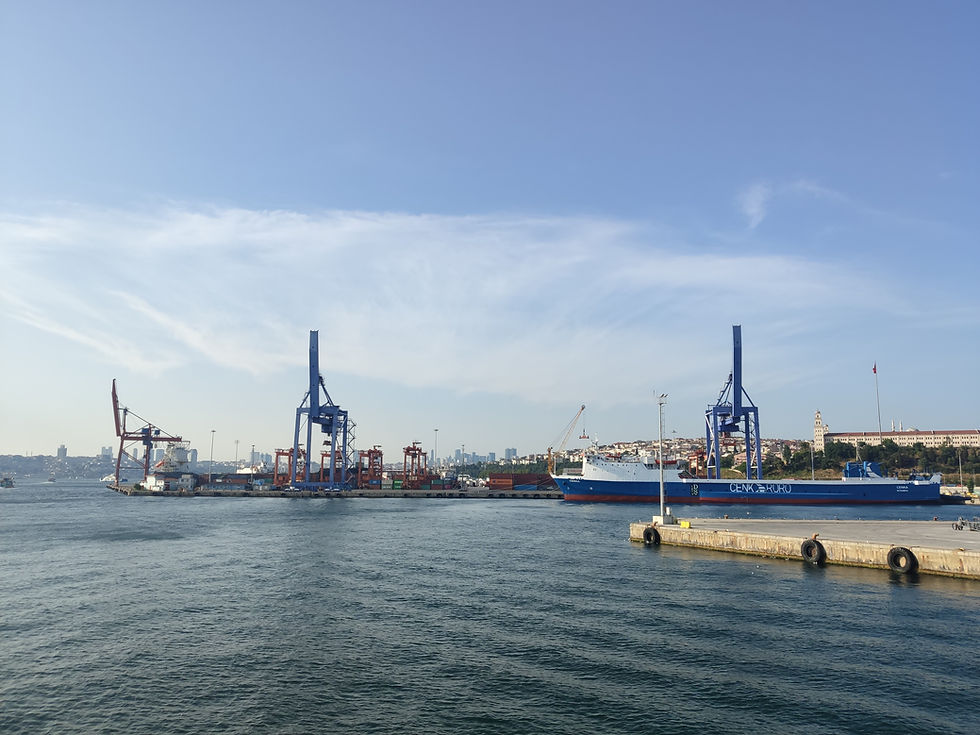
Our hostel was supposed to organize a pub crawl that night, but it was canceled because there were almost no women staying there. Going out alone with other guests was a surefire way to get scammed, as some of our roommates had reported that morning after being asked for absurd cover prices to enter nearly-empty venues, so we decided to stick with a calm dinner. We were joined by Mohsen, a Bahraini on his first-ever backpacking trip (who also asked me if toilets in America had water in them), and Kailash, whom we happened to encounter in the lobby after hearing reports that he was at the Black Sea. We had delicious lahmacun (flatbread topped with minced beef) at a nearby restaurant where Kailash seemed to know all the waiters, and the bill for the four of us was 80 TL ($9).






































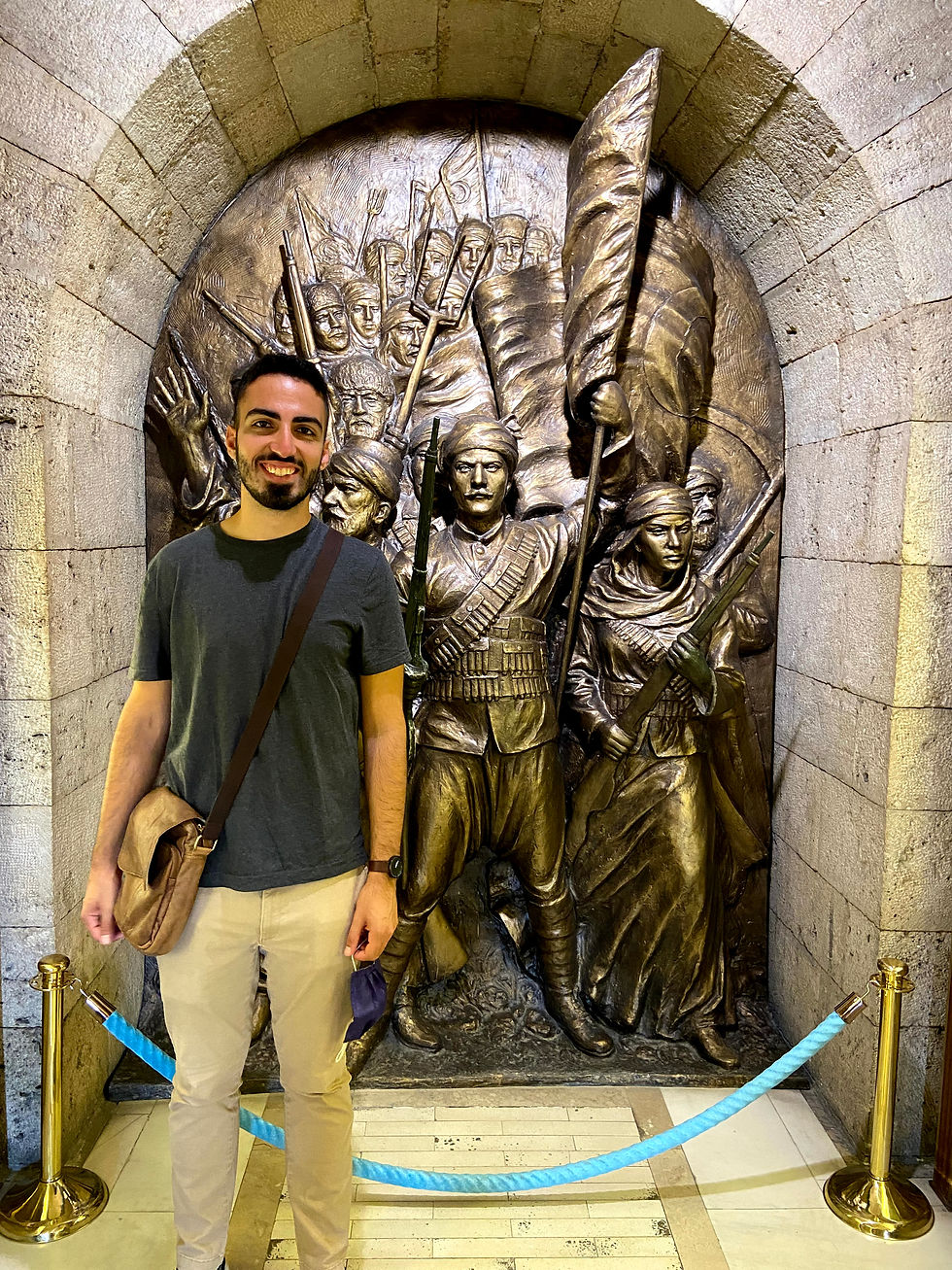












































you are an amazing “raconteur” one almost feels like he is walking right along your side!